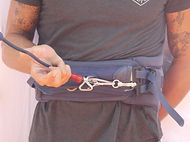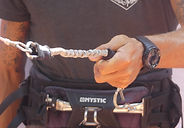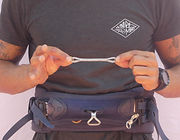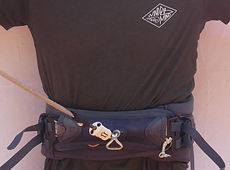

Placement of the safety leash
The International Kiteboarding Organization recommends the use of a short leash, on the front of the harness* https://www.ikointl.com/node/328149
The use of a long leash is not necessary for the vast majority of kite-surfers today. If you don't unhook, a leash long can cause potential problems. It could wrap around your legs or your barbell.
Fitting a short leash to the front of the harness is highly recommended. For example, during a problem during navigation, you must activate your quick release of your chicken loop. The lines could wrap around the bar. The kite could therefore start in " Deathloop " or at least continue to develop a lot of power. If the leash is placed on the back of the harness, it will be very difficult to release.
However, the use of a short leash placed at the front of the harness is not necessarily sufficient to progress in complete safety.
It is important to test your safety system a second time if the leash gets stuck under the harness buckle.
The drop takes place correctly in both cases, my location, FOR THIS LEASH is validated .
- FAQs -
“ I have a specific location on my harness so I'm safe ! ”
No, using the location provided for the leash does not necessarily mean being 100% safe
For example Here I am using a short leash on the specific location at the front of my harness.
Under normal conditions, there is no problem activating the system. However, we can clearly see that the release does not take place correctly if the leash is under the buckle of the harness. The small piece of iron gets stuck in the hook and the leash makes the release impossible.
As long as there is no significant loss of tension in the safety line, the leash will remain blocked and the rider will therefore be in danger.
Another example with another harness and another leash: This works under normal conditions.
In the event of passing under the hook, the activation of the system becomes completely impossible. In this case, the hook of the harness blocks the white mobile part, and therefore the release is impossible.
The only escape for the rider in this case would be to pass the leash under the hook in order to release it. This maneuver can be extremely difficult and therefore it is advisable to find a new location.
“ But what if my current system doesn't work ? ”
I t is quite possible to make your "setup" effective with un little thought and DIY.
Using an extension I can use this leash on the specific location of my harness :
“Why not use the harness hook to hang my leash? ”
it is quite possible to use your harness buckle but it is not necessarily a good idea.
With my harness buckle and this leash, it works in normal conditions.
But also if the leash is rolled up under the harness buckle.
Be careful, here again it is not flawless. With OTHER leash for example this does not work :
But with add extension it might work
Conclusion :
We can therefore see that it is very complicated to state strict rules that work for all harnesses for the placement of your SAFETY LEASH.
Common sense, reflection and exchange with other practitioners should be our weapons in order to evolve safely and try to anticipate certain problems.
I advise you to talk about it around you and to submit your friends' harnesses and leashes to these little tests.
This small failure is relatively recurrent (from my experience), and there are surely others. Confronter les avis will increase the average security level on the spots.
Warning: just because you've never had problems with your current Set-up doesn't mean you can't have one._cc781905-5cde -3194-bb3b-136bad5cf58d_
Feel free to leave your comments below to discuss or debate one or more points of this article.
Dimitri
WindMind Team
Thanks: Eleveight / PA Guillemot / C. Rodriguez / Cléa.
IMPORTANT SECURITY UPDATE




























